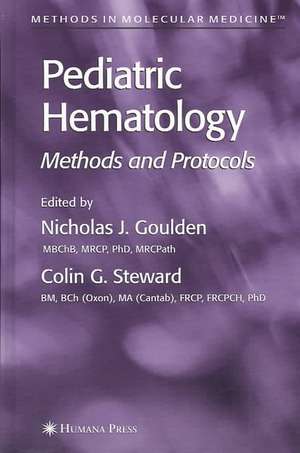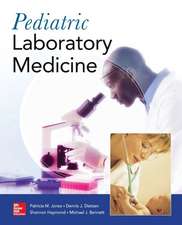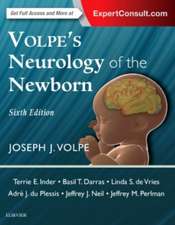Pediatric Hematology: Methods and Protocols: Methods in Molecular Medicine, cartea 91
Editat de Nicholas J. Goulden, Colin G. Stewarden Limba Engleză Hardback – 29 sep 2003
| Toate formatele și edițiile | Preț | Express |
|---|---|---|
| Paperback (1) | 714.63 lei 6-8 săpt. | |
| Humana Press Inc. – 9 aug 2013 | 714.63 lei 6-8 săpt. | |
| Hardback (1) | 722.48 lei 6-8 săpt. | |
| Humana Press Inc. – 29 sep 2003 | 722.48 lei 6-8 săpt. |
Din seria Methods in Molecular Medicine
- 5%
 Preț: 1278.74 lei
Preț: 1278.74 lei - 15%
 Preț: 655.78 lei
Preț: 655.78 lei - 5%
 Preț: 1106.50 lei
Preț: 1106.50 lei - 5%
 Preț: 727.44 lei
Preț: 727.44 lei - 5%
 Preț: 1108.72 lei
Preț: 1108.72 lei - 15%
 Preț: 650.55 lei
Preț: 650.55 lei - 5%
 Preț: 735.66 lei
Preț: 735.66 lei - 18%
 Preț: 947.35 lei
Preț: 947.35 lei - 18%
 Preț: 948.92 lei
Preț: 948.92 lei - 5%
 Preț: 1114.54 lei
Preț: 1114.54 lei - 5%
 Preț: 1114.91 lei
Preț: 1114.91 lei - 15%
 Preț: 658.55 lei
Preț: 658.55 lei - 5%
 Preț: 734.01 lei
Preț: 734.01 lei - 5%
 Preț: 1111.61 lei
Preț: 1111.61 lei - 5%
 Preț: 1104.32 lei
Preț: 1104.32 lei - 5%
 Preț: 723.21 lei
Preț: 723.21 lei - 5%
 Preț: 1106.13 lei
Preț: 1106.13 lei - 5%
 Preț: 723.05 lei
Preț: 723.05 lei - 5%
 Preț: 1108.35 lei
Preț: 1108.35 lei - 5%
 Preț: 723.42 lei
Preț: 723.42 lei - 5%
 Preț: 1115.65 lei
Preț: 1115.65 lei - 5%
 Preț: 786.86 lei
Preț: 786.86 lei - 5%
 Preț: 1133.01 lei
Preț: 1133.01 lei - 5%
 Preț: 1114.71 lei
Preț: 1114.71 lei
Preț: 722.48 lei
Preț vechi: 760.50 lei
-5% Nou
Puncte Express: 1084
Preț estimativ în valută:
138.26€ • 150.13$ • 116.14£
138.26€ • 150.13$ • 116.14£
Carte tipărită la comandă
Livrare economică 22 aprilie-06 mai
Preluare comenzi: 021 569.72.76
Specificații
ISBN-13: 9781588290434
ISBN-10: 1588290433
Pagini: 272
Ilustrații: XII, 272 p.
Dimensiuni: 155 x 235 x 24 mm
Greutate: 0.59 kg
Ediția:2004
Editura: Humana Press Inc.
Colecția Humana
Seria Methods in Molecular Medicine
Locul publicării:Totowa, NJ, United States
ISBN-10: 1588290433
Pagini: 272
Ilustrații: XII, 272 p.
Dimensiuni: 155 x 235 x 24 mm
Greutate: 0.59 kg
Ediția:2004
Editura: Humana Press Inc.
Colecția Humana
Seria Methods in Molecular Medicine
Locul publicării:Totowa, NJ, United States
Public țintă
ResearchCuprins
Bone Marrow Failure Syndromes.- Molecular Diagnosis of Fanconi Anemia and Dyskeratosis Congenita.- Molecular Diagnosis of Diamond-Blackfan Anemia.- Red Blood Cell Disorders.- Antenatal Diagnosis of Hemoglobinopathies.- Platelet and Hemostatic Disorders.- Prenatal Diagnosis of Hemophilia.- Human Platelet Antigen Genotyping by PCR-SSP in Neonatal/Fetal Alloimmune Thrombocytopenia.- Multiplex PCR for the Detection of the Factor V Leiden and Prothrombin 20210A Mutations.- Immunodeficiency.- Molecular Diagnosis of Congenital Immunodeficiency.- Acute Leukemia.- Molecular Techniques to Improve Outcome in Childhood ALL.- Molecular Cytogenetics in Childhood Leukemia.- Fluorescent IgH Fingerprinting to Assess Minimal Residual Disease in Childhood B-Lineage ALL.- Real-Time Quantitative RT-PCR to Detect Fusion Gene Transcripts Associated With AML.- Real-Time PCR to Detect Minimal Residual Disease in Childhood ALL.- Oligonucleotide Microarray Analysis of Gene Expression in Leukemia.- Bone Marrow Transplantation.- HLA Low-Resolution Genotyping for Hematopoietic Stem Cell Transplantation.- DNA Sequencing as a Tissue-Typing Tool.- Analysis of Chimerism After Stem Cell Transplantation.
Recenzii
"Pediatric Hematology, Methods and Protocols, is an excellent reference book for physicians and scientists who serve pediatric patients in the specialty of hematology. This book is a valuable technical manual for laboratory scientists to set up new diagnostic tests and to troubleshoot and improve their current diagnostic methods. It is also a very practical guideline for physicians to choose relevant tests to arrive at correct diagnoses in light of clinical history and symptoms. The book is well organized, concisely written, and easy to understand. To the best of my knowledge, no other book describes the molecular diagnostic methods of pediatric hematologic disorders in such detail. I highly recommend this book for laboratories of hematology and molecular diagnosis in hospitals serving pediatric patients." -Society for Pediatric Pathology
"The information in this book is clearly expressed...a useful and practical text for laboratory scientists..." - Journal of Pediatrics and Child Health
"The information in this book is clearly expressed...a useful and practical text for laboratory scientists..." - Journal of Pediatrics and Child Health
Textul de pe ultima copertă
Molecular techniques are now an integral part of the practice of modern pediatric hematology. In Pediatric Hematology: Methods and Protocols, hands-on masters of laboratory techniques describe their best methods for investigating and detecting a wide variety of hematological disorders. Here, the reader will find cutting-edge molecular protocols for the diagnosis of Fanconi anemia, dyskeratosis congenita, immunodeficiency, and most forms of hemoglobinopathy. In addition, there are detailed methods for molecular human platelet antigen genotyping, an effective PCR procedure for thrombophilia screening, and protocols for fluorescent in situ hybridization for cases in which insufficient metaphases are recovered or cryptic translocations are not visible. Since the measurement of minimal residual disease (MRD) provides a much more accurate risk-directed therapy, three methods are presented for detecting residual leukemia below the threshold of light microscopy, along with relatively simple, rapid, and inexpensive methods for the detection of MRD in ALL and AML. On the cutting-edge of technology, microarrays are used for the analysis of gene expression in childhood leukemia, and novel methods of graft engineering and reduced intensity conditioning regimens are applied to tissue typing for the assessment of donor/recipient chimerism. Each readily reproducible protocol is described in step-by-step detail and includes an introduction to the principle behind the method, equipment and reagent lists, and tips on troubleshooting and avoiding known pitfalls.
Cutting-edge and highly practical, Pediatric Hematology: Methods and Protocols offers experimental and clinical investigators a gold-standard collection of reliable molecular techniques essential to the diagnosis, classification, and treatment of childhood hematological disorders.
Cutting-edge and highly practical, Pediatric Hematology: Methods and Protocols offers experimental and clinical investigators a gold-standard collection of reliable molecular techniques essential to the diagnosis, classification, and treatment of childhood hematological disorders.







